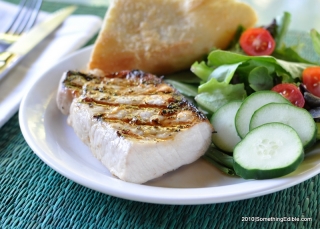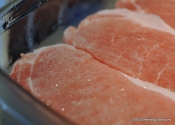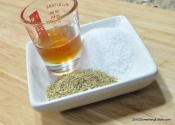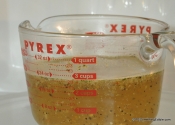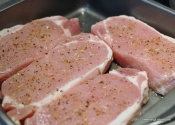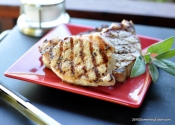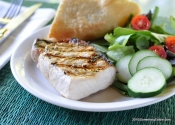Some food, some drink.
Renegade grilling: The Turbo Brine.
Abstract: If you buy meat in bulk (and if you're trying to feed a family, you should), there always seems to be a problem with logistics regarding the time it takes to thaw a potential main course. For boneless cuts that are usually cooked through, a quick brine can take you from freezer to grill in about 2 hours; all without the worry of an over-cooked dried-out piece of grill jerky. The technique I like to call the 'Turbo Brine' has been tuned for use with boneless cuts of poultry, and (in this case) pork. Turbo Brining uses the brine to thaw the frozen cuts meat and unlike using running water or the microwave (ugh, seriously?), the brine ensures that the subject of your grilling remains juicy and flavorful.
Purpose: First and foremost, let me cover
my ass:I have used this preparation for friends and
family (including my kids) a number of times and it always turns out
great. However, I am not your grill guardian angel. Because I'm not
there to hold your hand through the entire process, and the
variables from producer to table are infinite, I cannot guarantee
your safety if you don't handle your meat properly (that's what she
said). Always use proper
safe handling techniques and if the idea of a few days in your
loo and/or local infirmary scares you, always cook meat to
recommended
doneness.
Even on nice days, the wind has the ultimate say as to whether or
not I'm grilling. Those accessory burners they put on gas grills are
absolutely useless in western Kansas, but the grill itself is quite
functional when the winds are less than gale-force. The whole
situation can make grilling around here a bit spontaneous.
Conversely, meal planning from deep freeze just ain't for the
fickle.
As I was brining some pork loin chops early this
grilling-season, it struck me that there was a lot of wasted heat in
the system. When I create a brine, the options are to either let the
hot brine come back to room temperature and refrigerate, or make the
stuff at double-strength before adding ice. It's not at all
convenient, and I would wager that this is the reason most folks
don't brine. In a brief moment of clarity, it occurred to me that
the meat I was intending to brine was itself a big chunk of ice in
its then-present state. If I could leverage that cold to quickly
cool my brine without scalding the meat in the process, there would
be no excuse for dry, overcooked chicken breast and chewy, insipid
pork chops ever again.
Recipe: Jump to the detailed recipe. (or, keep reading for the gist of it) -
Brine Concentrate
The Rest
Combine 20 oz water, honey, kosher salt and seasoning blend in a micro-safe (Pyrex) container. Nuke for 3-5 minutes, or until the solution just starts to think about boiling. Add frozen meat to a brining vessel that will allow complete immersion, add 20 oz cold water. and LASTLY the hot brine. Stir, cover & move to the fridge for 90 minutes, agitating the container occasionally. After time has elapsed, the meat should be completely thawed, but still cool.
When ready to grill, remove from brine, pat dry, lube with a little olive oil, and add additional salt-free seasoning (if you want). Grill to desired doneness.
Observation:
- In order for this brining system to work, it's important to use boneless cuts that are no thicker than an inch and a half. Bone holds heat differently than muscle, and there is no guarantee that the thaw will be complete if the subject of de-frost isn't of consistent makeup.
- Don't go tinkering with the ratio of brine to meat. Two pounds frozen is just about the limit of the brine's capacity to negate the freeze. Any more meat than that will eventually thaw, but will likely take longer than what is allowable in the “danger zone".
- Physics was really
never my thing. However, if I did learn something, it's that water
is an awesome heat sink. It takes
a lot of energy to get H2O to change from one state to the
next, and we want to use that to our advantage. Even though we want
to allow that hot brine to thaw the subject of our grilling, we
don't want to start cooking it either. Putting the frozen meat in
cold water first works as a buffer to prevent scalding when the hot
half of the brine is added. To illustrate, let me throw a few
numbers at you -
- 4 minutes in my 1400W microwave will bring the temperature of the brine concentrate to 180F. This temperature is just on the low-end of what will slow-cook meat.
- Adding the cold tap water to the frozen chops yields a water temperature of 66F
- Immediately after adding the hot brine to the cold water and meat, the temperature plummets to 109F. At this point, all but the outer layer of our pork chops are still frozen solid.
- After 90 minutes in the fridge, our brine as well as the pork chops are both at 56F. The meat is completely thawed, and at the optimal temperature for even-cooking. In other words, there is no resting period out of the fridge needed, thus lessening the total time for exposure to microbes that may want to ruin our cook-out.
- Just because we didn't need a rest coming out of the fridge, doesn't mean that one isn't required coming off the grill. Give your slabs of grilling mastery about 5 minutes' rest before consuming so all those juices you worked so hard to retain can find a place to stay.
Results: Between you, me, and the Internets, I was torn as to whether or
not I was gonna write up this technique, as it plays the grey area
with respects to according-to-Hoyle food-safety. That said, the USDA
grilling FAQ states that you gotta refrigerate perishable food
within two hours, or it's not safe to cook. Seeing as
we're going from frozen
straight to the grill within the two hours safe limit, I think we're
in the clear here. If anything, I would argue that meat can now be
cooked to higher temperature (if that's your thing) because the
brine solution is more likely to keep the meat from drying out.
I'll add another couple of points in favor of the Turbo Brine, as
for the duration of its thermal transition, the meat is enveloped in
salt-saturated and honey-laced solution. Both
sugar and salt have long been known for their anti-microbial
properties.
The Turbo Brine does not disappoint. Every bite of pork loin chop
is juicy and tender. Boneless, skinless chicken breasts may even
lose their reputation for being dry and flavorless. Even a novice
griller will be receiving post-meal accolades. Forget about the
expensive bottles of marinade in the condiment aisle at the store.
They can't come close to the flavor jump-start furnished by pennies
worth of salt, sugar and seasoning.
Notes: If you're a big nerd like me and you want to know how brining works, Cooking for Engineers has a great write-up that's easy to understand. Bet you're wishing you woulda paid attention when they were talking about osmosis in junior-high science about now, huh?
Gallery:
These boneless pork loin chops are about 1.25 in thick and frozen solid after an extended ride in my chest freezer. In less than two hours, we'll be eating.
These boneless pork loin chops are about 1.25 in thick and frozen solid after an extended ride in my chest freezer. In less than two hours, we'll be eating.
Salt, salt-free seasoning, and honey: These three ingredients (plus a little water) are secret weapons in the war against dry and over-cooked grill fare.
Salt, salt-free seasoning, and honey: These three ingredients (plus a little water) are secret weapons in the war against dry and over-cooked grill fare.
This is how defrosting should be done in the microwave oven. The prepared brine concentrate is now ready to work its thermal and biochemical magic.
This is how defrosting should be done in the microwave oven. The prepared brine concentrate is now ready to work its thermal and biochemical magic.
After 90 minutes in the brine, the pork loin chops are completely thawed and at a proper resting temperature that ensures even cooking. Additional…
After 90 minutes in the brine, the pork loin chops are completely thawed and at a proper resting temperature that ensures even cooking. Additional seasoning and maybe a splash of oil is applied now.
Our Turbo-brined prok chops, just off the grill and doing a five minute rest before consumption. Sexy grill marks courtesy of a quarter-turn half-way thru…
Our Turbo-brined prok chops, just off the grill and doing a five minute rest before consumption. Sexy grill marks courtesy of a quarter-turn half-way thru grilling each side.
Get Social
Please wait while my tweets load...
Get the latest recipes and news. Join our Facebook page!



